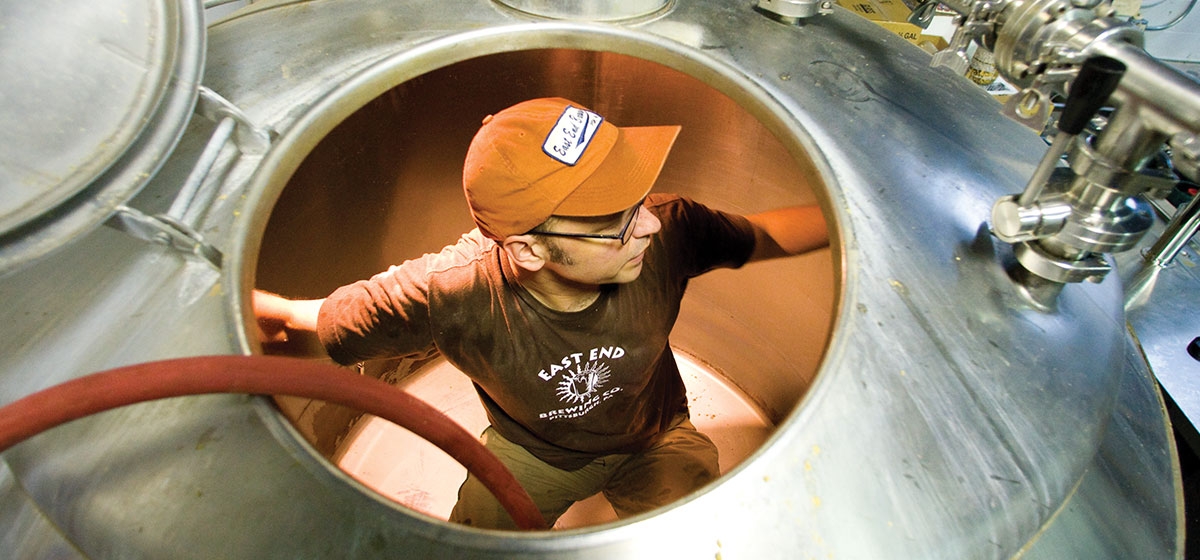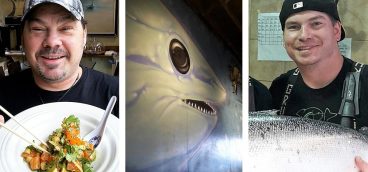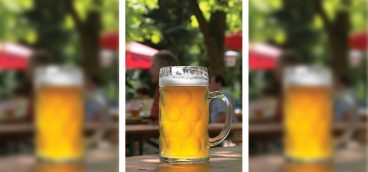Driven to Drink

We’ve been conditioned to think of beer as decision-making’s devoted contaminant, so when I tell you that beer almost single-handedly explains Scott Smith’s current whereabouts, you might think this story won’t end well. Four years ago, Smith worked for a Fortune 500 company in a consumer products job.
[ngg src=”galleries” ids=”37″ display=”basic_thumbnail” thumbnail_crop=”0″]
But the longer he did this, no matter where he lived — Chicago, San Francisco, later Pittsburgh — the more he wanted to stop. To complicate matters, he had both a hobby (brewing beer at home) and a goal (brewing beer for real). So he weighed the virtues of exiting Corporate America in two seminal conversations, one with his pal Gary (at a local brewpub, they talked over beers) and later at home with his wife (“I probably had a beer in my hand then as well,” Smith says). Suffice it to say, in these negotiations, beer proved quite the advocate for itself.
Now, Smith owns and operates the East End Brewing Company; he is the East End Brewing Company. It’s a one-man microbrewery in Homewood that last year produced 420 barrels of craft beer, most of it derived from five or six recipes: a rich, molasses-infused stout; a wheat beer spiced with lots of zesty comestibles, including coriander; and his flagship beer, Big Hop IPA, a hazy orange achievement that now accounts for 70 percent of the East End output.
Other than Smith and the odd customers who pick up growlers and kegs on site, nobody goes to East End. It’s not a brewpub. It features no bar, no food, no service. It features, in fact, no windows and no sign, other than the address inked, in semi-graffiti script, across the front door. Four years ago, when Smith surveyed the area — he walked block by block through the neighborhood — he called the telephone number tacked to this tattered red brick warehouse and asked the owner if he could move in. That call, it turned out, saved the building from its date with demolition.
Smith rationalized his decision in several ways. For one thing, as he told Gary, he felt miserable with his office job — at that time, with Clorox. For another thing, he loved the craft of making beer, art in liquid form. As a homebrewer, he played with ingredients and styles; he studied like a scholar. He wanted to “put more beer into the world than I was taking out.” And, on a final note, he realized that beer — good beer — could contribute in some humble but tangible way to the general human condition. With more craft beer in the market, fewer would find excuse to drink the sorry fizz of Miller, Coors and Budweiser — the American Lager genre, largely an invention of marketing, promising everything, too tasteless to be anything. By founding his microbrewery, Smith set out to challenge the way people drink, and think about, beer.
Our taste, or lack thereof, for beer owes attribution to the way we first experience it. Most of us take our first sips from a keg (sometimes, in the worst-case scenarios, while positioned upside-down, legs held aloft by friends), or from a Solo cup, or from a funnel. We drink the cheap stuff. We appreciate it not for its quality, but for its ability: Beer makes us feel good and helps men meet women or laugh at recycled movie lines. (On occasion, this beer will also help Clydesdales kick extra points.) So, for beer geeks — said beverage’s oenophile equivalent — we often remember not our First Time, but our Next Time. A time when we realize, finally, beer’s potential as a specialty product, not just a commodity.
Smith always liked beer — his senior year at Penn State, he lived in a frat house not because he belonged as a member, but because “they had beer on tap.” Only as a young professional in Chicago did he learn about better beer. At one bar in Wrigleyville, he tried the roasty, full-bodied Kalamazoo Stout, brewed by Bell’s. That set his devotion in motion.
Throughout 2004, he outfitted his 4,000 square feet of brewing space with all the necessary supplies: a used mill and grist case, three fermenters, a used hot liquor tank, a glycol chiller, a walk-in cooler, 60 feet of brew kettle ventilation ductwork and stainless steel heat shielding. Smith installed everything, he says, “except for the life-threatening stuff.” By the last days of 2004, East End began producing beer — first, strictly Big Hop. Smith knew nothing about business, so he followed his instincts and dogmas.
Vegetarianism, for instance. All of his beers meet vegetarian standards — worth noting if only because Guinness, to clarify its fermented beer, uses the pulverized remains of a sturgeon’s bladder.
When possible, Smith buys used equipment and local ingredients. He likes his beer au naturel, unfiltered. “You have to understand,” his friend, Gary Chodikov, says, “Scott started his first corporate job wearing three-piece suits, but he also had hair down to his shoulder blades. I can’t tell you how much [trouble] we gave him because he was a vegetarian, but he still did it. He never seemed to care what others thought.”
“It came down to this,” Smith says. “Like every home brewer, there’s a little voice in your head saying, ‘Maybe you could do this for a living.’ I think everybody has that voice. I was just a little more delusional in actually listening to it.”
* * *
There comes a point in most East End-centric conversations — sometimes about three sentences into Smith’s story — when he makes a point to discredit the widely circulated theory that he’s living the thirsty American’s dream. More than half of his job, he says, is custodial. When freed from cleaning machinery, he updates his Web site, orders brewery merchandise, handles publicity, etc. In a gratuitous attempt for sympathy, he tells you another downside of his job: namely, he must drink at strange hours, to the point of palate fatigue. Days before I meet him for the first time at the brewery, he spent one particular day “testing the viability” of 10 kegs. To translate, he was getting half-soused. At 9 a.m.
Smith’s venture coincided with — or perhaps aided — a regional craft beer boom. Like most movements, a demand for better beer began on the coasts, where microbreweries like Sierra Nevada (est. 1981) and Sam Adams (est. 1985) replicated the quality beers long adored in Europe. In Pittsburgh, several early microbreweries/brewpubs preceding East End — The Foundry Ale Works, Valhalla — failed to survive. But now? “Simply put,” said Todd Alstrom, co-founder of beer geek Web site beer advocate.com, “[Pennsylvania] is one of the largest and most passionate beer scenes in the U.S.” In Eastern Pennsylvania, Troegs, Victory and Stoudt’s, to name a few, produce a lineup of widely available and sometimes sublime brews. (Men’s Journal once called Victory’s Prima Pils the “Platonic ideal” of an American pilsner.)
In our region, restaurants and bottleshops offer expanded beer lists, sometimes specializing in the local crafts. The Church Brew Works in Lawrenceville, the Penn Brewery on the North Side, Sprague Farm & Brew Works in Venango and the North Country Brewing Company in Slippery Rock all create their own brews. But, to put my biases on full display, no aforementioned local beer maker can match the aromatic, toe-tingling oomph of East End’s stout; and none can match the clean made-for-summer ahhh of East End’s IPA.
To hear Smith tell it, though, the American beer scene — at once his competition and his inspiration — is still recovering from the legislative gaffe of Prohibition. During beer’s 13-year hiatus (1920-1933), the once vast and dynamic American brewery scene wilted. The ensuing decades, with beer brewed mostly for functionality, honed our modern understanding of the beverage, its image built on sporting events, slurred speech and painted, hirsute bellies. The first hope for a counter movement arrived in 1978, when President Carter signed a bill to legalize home brewing, triggering the imaginations of several pioneering beer lovers. To condense this history lesson, we’re now seeing the flavorful after-effects of that bill: The craft brewer’s market swelled 11.7 percent in 2006. Oregon-based Rogue brewing has beers inspired by Chef Masaharu Morimoto (available in a 22-ounce silk screened bottle); Draft magazine explains to beer lovers, attempting to diagnose viscosity, how new-issued brews flow over three parts of the tongue; and Beer advocate.com houses an encyclopedia of user comments rating 30,000 beers, Smith’s included, with the detailed analysis wiser minds might reserve for a Rembrandt.
“It’s elevating beer to a kind of wine status,” Smith says. “In Pittsburgh, that had been running in small circles for a while, but now it’s eking into the mainstream.”
In the last months, Smith has partnered beer with the friends who can rehab a lowest-common-denominator image. Culture, for instance: He served East End beer at a local art gallery opening. Health: He brewed a specialty ale to serve after a Pittsburgh bike ride. High-end cuisine: He’s currently planning a tasting dinner with Bigelow Grille chef Kevin Sousa in which they’ll couple courses with East End beers.
And then, there’s the laboratorial circumstance in which a course — enough food for dozens of them, actually —becomes an East End beer. Last year, Smith joined with a friend — Tom Baker, another adventurous brew master — to create a kvass, a traditional Russian beer made from rye bread. They picked up 30 loaves of bread from the Wood Street Bread Co., in Wilkinsburg, returned to the red warehouse and listened to polka music. The resulting, messy process — mixing, mashing, heating, dumping — depends on semi-Neanderthal terminology, but the upshot was that Smith finished with a starchy and arguably enjoyable, experimental beer. “Originally it was a poor man’s drink,” he says. “You’d have all this old and crusty bread in your house, and it’s too stale for soup.” His face twists into a grin: “You know, so why not ferment it?”
* * *
On the last weekend in July, I followed Smith to the statewide BrewExpo — an annual State College-based festival that, for two four-hour tasting sessions, marries dozens of microbrewers (and their lineup of products) with several thousand rapacious drinkers. The format works like this: The beer makers set up their kegs and taps along the perimeter of a hotel conference room. For a few moments, everything is clean and organized. Then, the gates open to the public, and you basically have the Storming of the Bastille, pint glasses subbed for artillery.
Here, you’re flung into the vortex of the craft beer movement. The crowd was 80 percent male, and, in similarly disproportionate numbers, outfitted in T-shirts with famous sayings (“Beer is proof that God loves us and wants us to be happy” — Ben Franklin) or novelty manifestos (“Real men wear kilts”). For the record, at least one attendee was wearing a kilt. The Brew Expo posted its official motto — “Drink less, drink the best” — on a placard near the conference room entrance, and best I could tell, the crowd strictly obeyed the second part of that advice.
For hours, Smith stood behind his table and poured beer. Drinkers could sample his stout, his IPA, his wheat beer, his low-alcohol nut brown ale, or his kvass — whose tap handle consisted of a shellacked and preserved loaf of rye. Halfway through the tasting session, Smith announced to the crowd that his stout, Black Strap, would be served on cask; in other words, the beer would be pumped from a hand engine, without the carbonation force of a tap. Most typical bar drinkers wouldn’t notice the subtle flavor differences this creates, but here, drinkers rushed into frantic lines to sample what one described, almost out of breath, as “a drastically different flavor profile.”
So many beers in such a small setting allowed for a wonderful comparison. Delaware-based Dogfish Head offered tastes of its outlandish Raison D’Extra, a supercharged elixir that is, by volume, 18 percent alcohol. (Most beer is around 4- or 5-percent ABV.) Legacy Brewing, from Reading, Pa., provided its spicy/citric Euphoria, a Belgian-inspired ale that tickled the nerves of your throat. And make no mistake, among the lot, some beers were uninspired, some overwrought, a few even downright vile.
But Smith’s beers — not counting the limited-edition kvass — all fit the same profile. They felt useful — each perfect for a normal occasion: drinking on the porch, perhaps. They felt controlled, trademarked by fundamentals rather than gimmicky absurdities. They felt balanced, with just enough distinction to keep you wanting more, just enough normalcy to keep you feeling overpowered.
By the end of the day, drinkers stumbled from the conference room into the hotel lobby, squinting and laughing. Some, until this precise moment, had miscalculated the toll of the session. They folded into chairs and couches. A few groaned. Most smiled.
Of course, one can arrive at this state in numerous ways. Miller Lite, for instance, will guide one to drunkenness just as ably — saving some calories and money along the way. So what, then, is the argument for better beer?
“Some people, maybe they’re not that interested in what they’re drinking. They’ll just say, ‘Give me whatever,’ ” Smith says. “There are two approaches you can take with that. Some people, you can try to convert. Or, you can just say to yourself: ‘If everybody’s drinking Bud-Miller-Coors, that’s more beer for the rest of us.’”




